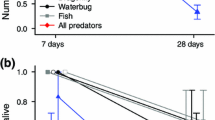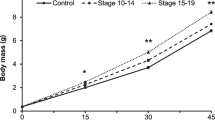Abstract
In animals with complex life cycles, fitness trade-offs across life stages determine the optimal time for transitions between stages. If these trade-offs vary predictably, adaptive plasticity in the timing of life history transitions may evolve. For instance, embryos of many species are capable of accelerating hatching to escape from egg predation and other hazards, but for plasticity in hatching timing to be selectively maintained, early hatching must also entail costs, probably in subsequent life stages. However the post-hatching environment, which influences this cost, is variable in nature. We assessed how two elements of the post-hatching environment, predator species and age structure created by hatching age plasticity, affect costs of hatching early in red-eyed treefrogs, Agalychnis callidryas. Red-eyed treefrog embryos were induced to hatch at the onset of hatching competence or near the peak of spontaneous hatching and exposed to one of three insect predators in single or mixed hatching-age treatments. Age structure created by hatching-age plasticity did not affect tadpole survivorship or growth; however, the consequences of hatching timing depended on predator species and foraging mode. Tadpoles that were induced to hatch early experienced initially higher mortality rates only with the more actively foraging predator. Nonetheless, mortality costs of accelerated hatching were apparent with all predators once we factored in the longer duration of exposure that early hatchlings experience in nature. This study suggests that extended exposure of young larvae to predators may be a general cost of early hatching, explaining why spontaneous hatching occurs later in life across variable environmental contexts.






Similar content being viewed by others
References
Chrzanowski TH, Simek K (1990) Prey-size selection by freshwater flagellated protozoa. Limnol Oceanogr 35:1429–1436
Cloarec A (1990) Factors influencing the choice of predatory tactics in a water bug, Diplonychus indicus Venk. & Rao (Heteroptera: Belostomatidae). Anim Behav 40:262–271
de Roos AM, Persson L, Thieme HR (2003) Emergent Allee effects in top predators feeding on structured prey populations. Proc R Soc B 270:611–618
Doody JS, Paull P (2013) Hitting the ground running: environmentally cued hatching in a lizard. Copeia 2013:159–164
Feder ME (1983) The relation of air breathing and locomotion to predation on tadpoles, Rana berlandieri, by turtles. Physiol Zool 56:522–531
Gomez-Mestre I, Warkentin KM (2007) To hatch and hatch not: similar selective trade-offs but different responses to egg predators in two closely related, syntopic treefrogs. Oecologia 153:197–206
Gomez-Mestre I, Warkentin KM (2013) Risk-induced hatching timing shows low heritability and evolves independently of spontaneous hatching in red-eyed treefrogs. J Evol Biol 26:1079–1089
Gomez-Mestre I, Touchon JC, Warkentin KM (2006) Amphibian embryo and parental defenses and a larval predator reduce mortality from water mold. Ecology 87:2570–2581
Gomez-Mestre I, Touchon JC, Saccocio VL, Warkentin KM (2008a) Genetic variation in pathogen-induced early hatching of toad embryos. J Evol Biol 21:791–800
Gomez-Mestre I, Wiens JJ, Warkentin KM (2008b) Evolution of adaptive plasticity: risk-sensitive hatching in neotropical leaf-breeding treefrogs. Ecol Monogr 78:205–224
Grant JWA, Noakes DLG (1987) Movers and stayers: foraging tactics of young-of-the-year brook charr, Salvelinus fontinalis. J Anim Ecol 56:1001–1013
Greene CH (1986) Patterns of prey selection: implications of predator foraging tactics. Am Nat 128:824–839
Hatle JD, Salazar BA, Whitman DW (2002) Survival advantage of sluggish individuals in aggregations of aposematic prey, during encounters with ambush predators. Evol Ecol 16:415–431
Huey RB, Pianka ER (1981) Ecological consequences of foraging mode. Ecology 62:991–999
Ireland PH (1989) Larval survivorship in two populations of Ambystoma maculatum. J Herpetol 23:209–215
Ireland DH, Wirsing AJ, Murray DL (2007) Phenotypically plastic responses of green frog embryos to conflicting predation risk. Oecologia 152:162–168
Kuhn M, Weston S, Wing J, Forester J (2011) Contrast: a collection of contrast methods. R package version 0.17. http://CRAN.R-project.org/package=contrast
Landberg T, Cohen KL, Willink B, Warkentin KM (2011) Effects of hatching age and predator cues on the development of escape swimming performance and survival with dragonfly predators in red-eyed treefrogs. Integr Comp Biol 51:E76
Li D (2002) Hatching responses of subsocial spitting spiders to predation risk. Proc R Soc B 269:2155–2161
McCoy MW, Bolker BM, Warkentin KM, Vonesh JR (2011) Predicting predation through prey ontogeny using size-dependent functional response models. Am Nat 177:752–766
Michel MJ, Adams MM (2009) Differential effects of structural complexity on predator foraging behavior. Behav Ecol 20:313–317
Moran NA (1992) The evolutionary maintenance of alternative phenotypes. Am Nat 139:971–989
Moreira PL, Barata M (2005) Egg mortality and early embryo hatching caused by fungal infection of Iberian rock lizard (Lacerta monticola) clutches. Herpetol J 15:265–272
Preisser EL, Orrock JL, Schmitz OJ (2007) Predator hunting mode and habitat domain alter nonconsumptive effects in predator–prey interactions. Ecology 88:2744–2751
Pritchard G (1965) Prey capture by dragonfly larvae (Odonata; Anisoptera). Can J Zool 43:271–289
Pruitt JN, Stachowicz JJ, Sih A (2012) Behavioral types of predator and prey jointly determine prey survival: potential implications for the maintenance of within-species behavioral variation. Am Nat 179:217–227
Rogge JR, Warkentin KM (2008) External gills and adaptive embryo behavior facilitate synchronous development and hatching plasticity under respiratory constraint. J Exp Biol 211:3627–3635
Rosenheim JA, Corbett A (2003) Omnivory and the indeterminacy of predator function: can a knowledge of foraging behavior help? Ecology 84:2538–2548
Sherk TE (1977) Development of the compound eyes of dragonflies (Odonata). I. Larval compound eyes. J Exp Zool 201:391–416
Sherratt TN, Harvey IF (1989) Predation by larvae of Pantala flavescens (Odonata) on tadpoles of Phyllomedusa trinitatis and Physalaemus pustulosus: the influence of absolute and relative density of prey on predator choice. Oikos 56:170–176
Skelly DK (1994) Activity level and the susceptibility of anuran larvae to predation. Anim Behav 47:465–468
Slos S, Stoks R (2008) Predation risk induces stress proteins and reduces antioxidant defense. Funct Ecol 22:637–642
Tanhuanpää M, Ruohomäki K, Uusipaikka E (2001) High larval predation rate in non-outbreaking populations of a geometrid moth. Ecology 82:281–289
Touchon JC, Warkentin KM (2010) Short- and long-term effects of the abiotic egg environment on viability, development and vulnerability to predators of a Neotropical anuran. Funct Ecol 24:566–575
Touchon JC, Gomez-Mestre I, Warkentin KM (2006) Hatching plasticity in two temperate anurans: responses to a pathogen and predation cues. Can J Zool 84:556–563
Touchon JC, McCoy MW, Vonesh JR et al (2013) Effects of hatching plasticity carry over through metamorphosis in red-eyed treefrogs. Ecology 94:850–860
Vonesh JR (2005) Sequential predator effects across three life stages of the African tree frog, Hyperolius spinigularis. Oecologia 143:280–290
Vonesh JR, Bolker BM (2005) Compensatory larval responses shift trade-offs associated with predator-induced hatching plasticity. Ecology 86:1580–1591
Vonesh JR, Osenberg WW (2003) Multi-predator effects across life-history stages: non-additivity of egg- and larval-stage predation in an African treefrog. Ecol Lett 6:503–508
Warkentin KM (1995) Adaptive plasticity in hatching age: a response to predation risk trade-offs. Proc Natl Acad Sci USA 92:3507–3510
Warkentin KM (1999a) The development of behavioral defenses: a mechanistic analysis of vulnerability in red-eyed tree frog hatchlings. Behav Ecol 10:251–262
Warkentin KM (1999b) Effects of hatching age on development and hatchling morphology in the red-eyed treefrog, Agalychnis callidryas. Biol J Linn Soc 68:443–470
Warkentin KM (2000) Wasp predation and wasp-induced hatching of red-eyed treefrog eggs. Anim Behav 60:503–510
Warkentin KM (2002) Hatching timing, oxygen availability, and external gill regression in the tree frog, Agalychnis callidryas. Physiol Biochem Zool 75:155–164
Warkentin KM (2011a) Environmentally cued hatching across taxa: embryos respond to risk and opportunity. Integr Comp Biol 51:14–25
Warkentin KM (2011b) Plasticity of hatching in amphibians: evolution, trade-offs, cues and mechanisms. Integr Comp Biol 51:111–127
Warkentin KM, Currie CC, Rehner SA (2001) Egg-killing fungus induces early hatching of red-eyed treefrog eggs. Ecology 82:2860–2869
Warkentin KM, Buckley CR, Metcalf KA (2006) Development of red-eyed treefrog eggs affects efficiency and choices of egg-foraging wasps. Anim Behav 71:417–425
Watkins TB (1996) Predator-mediated selection on burst swimming performance in tadpoles of the Pacific Tree Frog, Pseudacris regilla. Physiol Zool 69:154–167
Wedekind C (2002) Induced hatching to avoid infectious egg disease in whitefish. Curr Biol 12:69–71
Werner EE (1986) Amphibian metamorphosis: growth rate, predation risk, and the optimal size at transformation. Am Nat 128:319–341
Werner EE, Gilliam JF (1984) The ontogenetic niche shift and species interactions in size-structured populations. Annu Rev Ecol Evol 15:393–425
Acknowledgments
We thank the Autoridad Nacional del Ambiente de Panamá for permission to conduct this research (Permits SE/A-16-10 and SC/A-23-12) and the Smithsonian Tropical Research Institute for use of their facilities and logistical support. Animal use was approved by STRI (protocol 100625-1008-15) and Boston University (protocol 08-011). We thank Z. Costa, R. Greene, R. Komosinski, C. Noss, S. Schleier, and J. Touchon for assistance. Comments by two anonymous reviewers, the associate editor and the editor John Endler greatly improved the manuscript. Funding was provided by the National Science Foundation, USA (DEB-0716923 to K.M.W and 0717220 to J.R.V), Boston University, Virginia Commonwealth University and the Smithsonian Tropical Research Institute.
Author information
Authors and Affiliations
Corresponding author
Electronic supplementary material
Below is the link to the electronic supplementary material.
Rights and permissions
About this article
Cite this article
Willink, B., Palmer, M.S., Landberg, T. et al. Environmental context shapes immediate and cumulative costs of risk-induced early hatching. Evol Ecol 28, 103–116 (2014). https://doi.org/10.1007/s10682-013-9661-z
Received:
Accepted:
Published:
Issue Date:
DOI: https://doi.org/10.1007/s10682-013-9661-z




